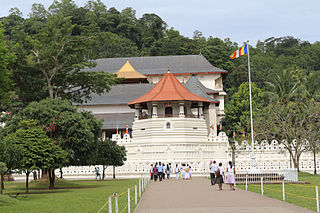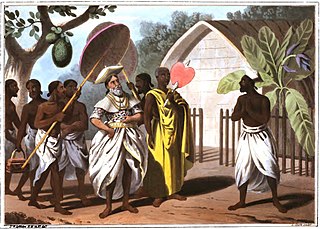
Kandy is a major city in Sri Lanka located in the Central Province. It was the last capital of the ancient kings' era of Sri Lanka. The city is situated in the midst of hills in the Kandy plateau, which crosses an area of tropical plantations, mainly tea. Kandy is both an administrative and religious city and is also the capital of the Central Province. Kandy is the home of the Temple of the Tooth Relic, one of the most sacred places of worship in the Buddhist world. It was declared a World Heritage Site by UNESCO in 1988. Historically the local Buddhist rulers resisted Portuguese, Dutch, and British colonial expansion and occupation.

Bishop's College in Colombo, Sri Lanka, is a private girls' school founded by the Anglican Church of Ceylon in February 1875.

The Trinity College Chapel in Kandy, Sri Lanka is one of the more distinctive church buildings in Sri Lanka. It is situated below the Principal's bungalow at Trinity College, Kandy. The chapel is one of the first and finest examples of the application of indigenous architecture in the design of an Anglican church in the country. The building is modelled on traditional Buddhist architecture, reminiscent of those found in Polonnaruwa, an ancient capital of Sri Lanka, in that it is an open building with a lofty hipped roof supported by numerous carved stone pillars.

Radala refers to a small minority group in Sri Lanka in the former provinces of the Kingdom of Kandy, who are either descendants of chiefs and courtiers of the King of Kandy of Nayaks of Kandy or descendants of native headmen appointed by the British colonial administration following the Uva Rebellion in 1818.
The Church of England Zenana Missionary Society, also known as the Church of England Zenana Mission, was a British Anglican missionary society established to spread Christianity in India. It would later expand its Christian missionary work into Japan and Qing Dynasty China. In 1957 it was absorbed into the Church Missionary Society (CMS).

The Theological College of Lanka (TCL) is a college that was inaugurated in 1963 by the Anglican Church, the Methodist Church and the Baptist Church in Sri Lanka. Later the Presbyterian Church joined the federation, to educate the new clergy (ministers) and laity in the environment and context of Sri Lanka and their own languages, Sinhala and Tamil. Rev. Basil Jackson, a British Methodist Missionary, became the founding Principal of the college in 1963.. It is believed that language is the vehicle of culture and when Christians begin to think, speak, preach, pray and write in their own languages, they soon become familiar with their cultural values and begin to appreciate them in the practice of their Christian faith. This new step was foreseen by all the churches as an attempt to produce indigenous theology by people who are being educated in Sri Lanka.

The American Ceylon Mission (ACM) to Jaffna, Sri Lanka started with the arrival in 1813 of missionaries sponsored by the American Board of Commissioners for Foreign Missions (ABCFM). Although they had originally planned to work in Galle, the British colonial office in Ceylon restricted the Americans to out-of-the-way Jaffna due to the security concerns of the British who were warring with France at the time. The critical period of the impact of the missionaries was from the 1820s to early 20th century. During this time, they engaged in original translations from English to Tamil, printing, and publishing, establishing primary, secondary and tertiary educational institutions and providing health care for residents of the Jaffna Peninsula. These activities resulted in many social changes amongst Sri Lankan Tamils that survive even today. They also led to the attainment of a lopsided literacy level among residents in the relatively small peninsula that is cited by scholars as one of the primary factors contributing to the recently ended civil war. Many notable educational and health institutions within the Jaffna Peninsula owe their origins to the missionary activists from America. Missionaries also courted controversy by publishing negative information about local religious practices and rituals.
St. Margaret's School (Secondary) (SMSS) is a government-aided autonomous girls' secondary school in Bukit Timah, Singapore, under the purview of the Anglican Diocese of Singapore. It is the first girls' school in Singapore and often regarded as the oldest existing girls' school in Southeast Asia.

The Church of Ceylon is the Anglican Church in Sri Lanka. It is an extraprovincial jurisdiction of the Archbishop of Canterbury, who serves as its Metropolitan. It was established in 1845 with the appointment of the first Anglican Bishop of Colombo, James Chapman and until 1950 it consisted of a single diocese; in that year a second diocese was established at Kurunegala.

Vijaya Rajasinha was a member of the Madurai Nayak Dynasty and succeeded his brother-in-law Vira Narendra Sinha as the King of Kandy.He was raised in Kandy and was familiar with the politics and culture of the court and society at large, including those of his Telegu kinfolk.

Sachini Ayendra Stanley, is a Sri Lankan film actress currently working in the Sinhala film industry. She won Miss Sri Lanka in 2003 and represented Sri Lanka at the 53rd Miss World Pageant in Sanya, China. After being crowned as Miss Sri Lanka, her first film, Aadaraneeya Wassaanaya, directed by Senesh Dissanaike Bandara, was released in 2004. She won the award for best supporting actress at Signis Sri Lanka Film Awards for her performance.
The Methodist Church of Sri Lanka is a Protestant Christian denomination in Sri Lanka. Its headquarters is in Colombo and was established on 29 June 1814. It is a member of the World Council of Churches, the Christian Conference of Asia, the National Christian Council of Sri Lanka and the World Methodist Council.

Trinity College, Kandy, is an independent Anglican day and boarding school for boys located in Kandy, Sri Lanka. It was founded in 1872 by British Anglican missionaries of the Church Missionary Society, modelled on British Public school tradition. Trinity offers primary and secondary education, and is a leading private school in Sri Lanka managed by the Anglican Church of Ceylon.

The zenana missions were outreach programmes established in British India with the aim of converting women to Christianity. From the mid 19th century, they sent female missionaries into the homes of Indian women, including the private areas of houses - known as zenana - that male visitors were not allowed to see. Gradually these missions expanded from purely evangelical work to providing medical and education services. Hospitals and schools established by these missions are still active, making the zenana missions an important part of the history of Christianity in India.
The Choir of Trinity College, Kandy, Sri Lanka, is a Boys' choir that continues a choral tradition dating back to the school's founding in 1872. The choir plays a central role in Christian worship at the school, which was founded by the Church Missionary Society, and continues its affiliations to the Anglican Church of Ceylon.
1815 in Sri Lanka marks the turn from the Kandyan period to the British Ceylon period, when the Kingdom of Kandy was disestablished and the creation of British Ceylon as the sole polity on the island.
Blanche Louisa Mary Boleyn Brenton Carey was a Church of England Zenana Mission Society (CEZMS) pioneer missionary to Karachi.
Helen Plummer Phillips (1850–1929) educator, missionary, philanthropist, was the first missionary sent from Australia by the newly formed Church Missionary Association NSW in 1892. She was the first tutor for women students at the University of Sydney and formed the University of Sydney Women's Society in 1891 and established its settlement work, mentoring the women students until the Women's College was built and the first principal arrived. Phillips was a principal of St. Catherine's School, Waverley NSW, an advocate for women's full education, and a benefactor of St Luke's Anglican Community Church, Medlow Bath, NSW.
Beatrice Marian Smyth (1894-1965) was an American physician and missionary who was a member of the Church of England Zenana Missionary Society (CEZMS). Smyth was in charge of the CEZMS mission in Rainawari, a locality in Srinagar City in Jammu and Kashmir state, India. She led the opening of the Elizabeth Newman Hospital in January 1937, and started a training school for nurses in Kashmir.














